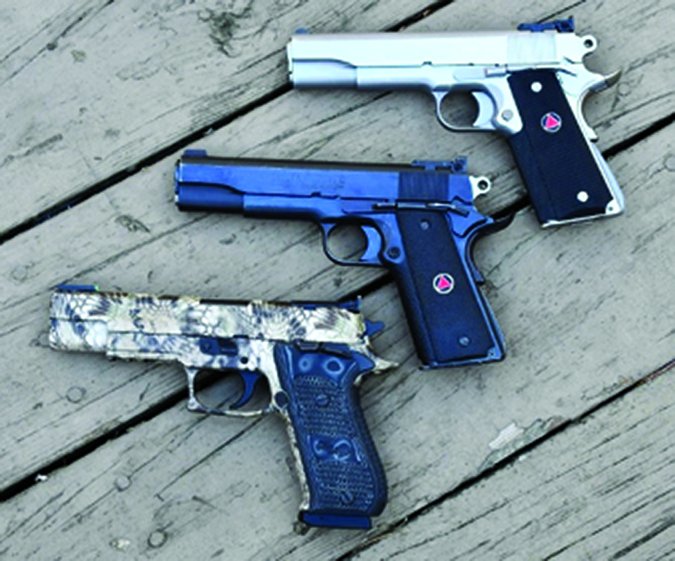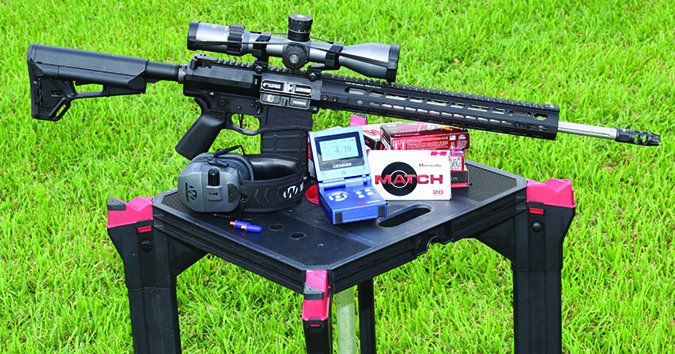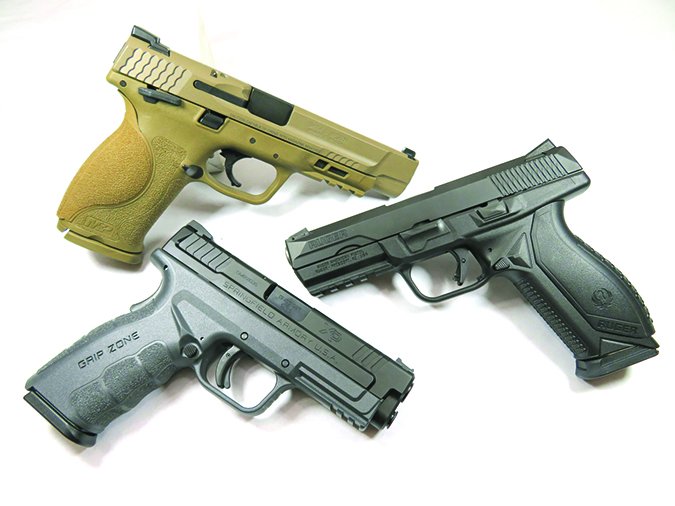Re “New Full-Size Striker-Fires From Ruger, S&W, Springfield,” December 2017
Todd, thank you very much for starting to include the slide-racking forces on your pistol tests. As I age, I am starting to develop arthritis in my thumbs and find that it is becoming hard or impossible to rack the slides on some pistols. For example, I have no problem racking the slide on my 1911, CZ 75, TCP, and Buckmark; but I could not comfortably rack the slide on my buddy’s SIG. I still enjoy shooting pistols and hope to be able to do it for a few years before I have to switch to revolvers. Slide-racking force will definitely be one of my considerations when I consider purchasing pistols in the future. Keep up the good work!— Raul
Raul, you are very welcome, and I apologize for the delay. We’ve talked about adding that metric for a few years, but it wasn’t until some companies started promoting “slide-racking effort” as a sales angle that the measurement became important to many shooters. — Todd Woodard
Re “Big-Bore Autos: Two More 10mms and One 357 Magnum,” November 2017

I appreciated your article on the 10mm Colt Delta Elites and S&W 1076. I have two Delta Elites made in the ‘80s, and a SIG P220R5-10-HP-SAO Kryptek Highlander camo. I also have a Series 90 Double Eagle 10mm.
When I got the Colts, I bought full-spec 10mm ammo and felt they were not enough gun for the round. I did, however, shoot them more accurately than 45 ACP Government Models.
Years later, a wide range of 10mm ammo was available, mostly what I call “40 S&W-Long” because the power factor is so close to 40 S&W ammo. Guns made for the 40s are usually smaller, and the ammo cheaper, so why bother with a 10mm if that’s what you want? Note: I can easily carry one or two Government Models concealed, but, like others, I appreciate compact packages. Accuracy from the Colts was still admirable.
Serious health issues sidelined me from shooting for a couple years, and when I resumed, I had also transitioned to “triple-pane” glasses, and my accuracy had declined considerably. I had the Colts modified with adjustable rear sights, and higher-profile front ones, as well as beavertail safeties. My accuracy was still mediocre, so I asked a much younger person to shoot them. He was drilling cloverleafs and 1-inch groups at 20+ meters. The problem was me.
As soon as SIG announced the P220-10, I got in line for one, waiting quite a few months for delivery. I produced notably better groups with it than the Colts. I again asked a younger person to shoot them, and he made nearly identical groups with all the guns. I have a long and happy history with SIGs and attribute my improvement to that.
My groups, shooting standing, off-hand, leaning back against a table, were about 4 inches at 15 meters. I won’t tell you what they looked like at 20+ meters.
I then fired all three while seated, with my elbows on a table. My groups were with most holes touching. Emboldened, I stood and fired at a 25-meter target, making about a 4-inch group. Sigh.
My big surprise was the ammo. I had PPU 180-grain rounds that I rate as 40 S&W-Long. I also had a handload I made up some 20 years ago, with 165-grain Remington BJHP bullets. Unfortunately, I have lost the record of the powder charge and primer. I used mixed brass. Out-the-muzzle velocity from the Colts is 1355 fps plus, which makes for a powerful round. It kicks that way, too.
Third was SIG Sauer’s Elite Performance V-Crown 180-grain JHPs, rated at 1250 fps with 624 ft.-lbs. of energy. Like the SIG Elite 357 SIG ammo I like, it proved to be hotter than advertised in all three guns. It kicked noticeably harder than the PPU, but I think the energy makes it a formidable and worthwhile round.
Firing from the table, I could see no difference in my groups. For all three guns, PPU ammo tended to hit right of center, while the SIG ammo and my handloads were centered.
The blue DE tossed shells 90 degrees to the right out to between 2 and 4 meters, and as much as two meters back. The first knuckle of my trigger finger was quite sore by the end of 100 rounds because the recoil bangs the trigger guard against it pretty hard.
The stainless DE tossed the shells from 2 to 4 meters out at 90 degrees, to 15 degrees forward. As with the blue gun, the trigger guard battered my trigger finger.
The SIG is about the same size as a 1911 and will fit in many holsters for them. However, it will not fit in a SIG 1911 holster. I got an Uncle Mike’s security holster for the P220 that works very well. If you can carry a Government Model 1911, you can carry the SIG.
Colt magazines were becoming expensive and hard to find. Maybe now that Colt is making the guns again, we’ll see them more readily available. The 8-round blue magazines I have, when filled, must be inserted with the slide back or they won’t lock into place. The stainless magazines, when full, could easily be seated with the slide forward.
SIG P220-10 magazines are expensive, but a person on the SIG forum said P220 45 ACP magazines would work just fine. Since I had a boxful, I got them out and tried them. All worked well, though I found I had to limit them all to seven rounds because an eighth round resulted in a nosedive on the first one. Loading the eight-round P220-10 magazine requires notably more effort to insert the last two rounds. I used an Uplula magazine loader, which worked well.
The SIG tossed the fired shells from 3 to 9 meters out, and 30 to 40 degrees back. The SIG thumb safety is a puzzle. It is advertised as having been deliberately made stiff “for safety.” Well, it is uncomfortably stiff, but I can push it off with my thumb or trigger finger. However, it is impossible to engage without shifting the gun and using both hands. That does not fit my definition of a safer gun. Note about the Kryptek camo: It’s really impressive to see, and that was why I ordered it. It makes for a cool-looking gun, but I don’t think the finish will last. For as little as I’ve carried it in a holster, I’m surprised at the wear I see on the rail, slide, and front of the frame. I can’t imagine it can be touched up.
I think any of them would make great trail guns, but for hunting I’d prefer the SIG because it feels more comfortable shooting full-spec rounds. I hope to go hog hunting in the near future to find out.
I’m still waiting for tests on 10mm self-defense ammo. I worry that full-spec rounds will overpenetrate, and I feel anything moving at 40 S&W-Long speeds would seem pointless in a 10mm gun. For now, I’ll stick with 357 SIG guns and ammo. They’re smaller, very accurate, and the round is quite effective with proven limited overpenetration.— Jan
Thank you for the detailed follow-ups on these handguns. This information could be very helpful to someone who was on the fence about buying one of the 10mm handguns we’ve reviewed recently. — tw
Re “Options in Precision Rifle: We Test Desert Tech, Howa, Ruger,” November 2017
I have been a long-time subscriber and fan of your magazine and always refer to your evaluations when making a new gun purchase. I was very much interested in your article about the long-range shooters, as I have always been a fan of the long shot. You start the article by stating, “… the popularity of rifles that are capable of accuracy beyond the 300-, 600-, or even 1000-yard range is still going strong.”

But the range data you provided was only for 100 yards. Why wouldn’t you provide us with range data more commensurate with these rifles capabilities? I’m sure your testers spend a lot of time at the range, so why not get data at 300 or 600 yards? That would have been very helpful for us when making a buying decision. — Peter
A valid point. — tw
Re Laser Tests
Greetings, Mr. Woodard. I have stopped all magazine subscriptions in favor of reading Gun Tests. I use the information when making purchase decisions. I wish I had found you when I began buying back in the day, but better late than not at all.
My recent job change has me working late morning to late evening, which turned out to be very beneficial. A month after starting, I caught someone checking my sliding glass door at 0730, just before the break-in was to begin. Sheriff even arrived in a very timely fashion, as he was already looking for them.
We were broke into a couple years ago when my wife was home alone, and I have made several changes since to address that. Some lessons stick with you a long time.
Two things I have found. Night sights work well to find the gun in a darkened room on the night stand, and Crimson Trace laser grips are an excellent visual deterrent because the beam reflects off the glass, curtains, floor, etc., as it did that morning.
I have considered buying another set of Crimson Trace laser grips for my 45 ACP 1911. I cannot justify $250 “on sale” or $300 otherwise. However, every Thanksgiving weekend, the sales begin. Example: I saw a Kimber Micro 9 Woodland with Crimson Trace grips for $500. That’s free grips. I also saw a Beretta 92 for $409, a Remington 1911 45 for $400 after sale and after rebate; a Ruger LCR 38 for $309; a Ruger LC9S for $300; an S&W Shield 9mm w/o safety, $279 through Thanksgiving weekend, or $300 until Christmas; and a Ruger LCP 2 for $220. So why buy just plastic grips with a laser and micro switch for $250 to $300 for a Kimber 9 or 1911 full size, when I could buy a whole package for $500? Or another pistol, maybe even with night sights? A complicated, reliable machined pistol, or molded plastic grips with micro switch, battery, and laser. Same price range. Either these fall prices are great deals, which they are, or Crimson Trace is way overpriced.
I don’t like the trigger mount, but Hogue now offers a grip and laser, as do other companies.
What do you think about a value and repeated accuracy test with some of the Crimson Trace competitors? I have found Crimson Trace to be reliable and accurate, but I have been hesitant to buy something else.

You all have a very good magazine, seems like the best job in the world. Are you hiring? Merry Christmas and Happy New Year to you and yours. — Dave
Dave asked, “What do you think about a value and repeated accuracy test with some of the Crimson Trace competitors?” I like it. On it. — tw
Re “New Full-Size 9mm Striker-Fires From Ruger, S&W, Springfield,” December 2017
I love my M&P9 Pro(s), and I’m an ardent S&W fan, but to compare the 5-inch-barrel Model M&P against the two 4- to 4.25-inch barrel Ruger and Springfield isn’t fair. I realize the M2 you tested doesn’t say it’s a Pro series, but the 5-inch versions have better balance, and because of the increased span in the sights, are bound to deliver more accuracy. Better to compare apples to apples. The M&P9 standard/duty does come in a 4-inch version. Great new issue all the way around, keep up the great work!— Marc
Yes, but. The two smaller pistols had an edge in weight and form size that many shooters would have looked at as big advantages in choosing a carry handgun. — tw




























